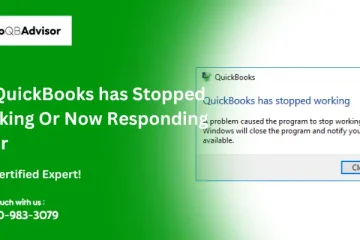The QuickBooks company file not found error occurs when the software fails to connect with the data file owing to a broken file path or other technical issues. As a result, you are unable to access your financial information or complete any accounting tasks. If QuickBooks is unable to connect with the data file, an error message stating QuickBooks can’t find your company file will appear whenever you attempt to open it from the No Company Open window. This is a common issue that is further addressed on the blog to help you understand its fundamental causes and expert-recommended solutions.
Company File Not Found in QuickBooks Desktop: Overview
The company file is not found. QuickBooks displays a notice indicating that the software failed to connect to the company file. This could be due to a changed location of the data file or a lack of folder permissions that prevent QuickBooks from accessing it. This error message is recurrent, and you will see it whenever you run a data file or execute any accounting action that requires it. After this issue develops, it may become hard to update new transactions in the data file. You must resolve this error as soon as possible to guarantee that the company file operates well and QuickBooks can access the financial details without issue.
Your financial data is not harmed as a result of this issue, and you can restore access to the data file by changing some system settings that may prevent QuickBooks from connecting to it. Frequent crashes or lags in QuickBooks are common when this issue arises, so there’s no need to panic if the software starts behaving unusually.
You may also see a different version of the error message that reads “Warning: The company file you selected could not be found.”
If you receive the above-mentioned message, it is most likely due to damage to the company file, which can be readily fixed using the troubleshooting methods described in this article. Before you begin troubleshooting, you should consider the various causes of this company file issue. This will help you better understand the situation.
Why Does QuickBooks Company File Not Found Error Occurs?
QuickBooks will not allow you to complete accounting tasks effectively if the company file you are attempting to run is inaccessible. The issue becomes annoying because you are unable to add new transactions or update your financial data. All of the possible causes of this company file not found issue in your QuickBooks Desktop are detailed below.
- The path to the company file changes when it is moved to a new location on the computer, but QuickBooks continues to look for the file in its previous location.
- The file was accidentally overwritten or removed from local or network storage.
- Incorrect hosting settings or Database Server Manager failing to start in the background while accessing a company file from a server might also cause this problem.
- There are particular methods for opening various file types (.qbw,.qbb, etc.). QuickBooks may encounter problems if you try to open a file incorrectly.
- The company file name is too long for QuickBooks to process, or it contains invalid symbols like <,%, $, #, etc.
- QuickBooks cannot open a company file owing to failed user permission caused by a damaged or missing QBWUSER.ini file.
- Physical damage or corruption in your system’s HDD can cause issues when QB attempts to access the company file.
- QuickBooks cannot find the company file or run properly if its software files are damaged or corrupted.
- Using an outdated or partially installed QuickBooks version can result in this issue.
- QuickBooks will be unable to access the company file if you are logged in with a non-admin Windows account that has the necessary rights to access system drives.
- A company file may fail to open if it is damaged during the transfer or as a result of a virus attack.
These are all the conditions that cause problems when QuickBooks attempts to connect with the data file. Let us now look at the troubleshooting methods that are most helpful for getting this problem out of your system.
Steps to Fix QuickBooks Company File Not Found?
You cannot use QuickBooks Desktop effectively because error messages appear anytime you access a data file from the No Company Open window. This problem might worsen and cause issues while performing other accounting operations in the software. You must resolve this issue as soon as possible to resume normal operation of your QuickBooks Desktop.
Now, let’s look at how to find the missing QuickBooks company file.
Step 1: Rectify DBSM Issues (For Multi-User Mode)
QuickBooks Company file missing might occur if the multi-user network is not properly configured. This can occur as a result of wrong hosting settings (workstations running in multi-user mode) or Database Server Manager crashing in the background every time you host or access data files. You must guarantee that DBSM functions smoothly by following the steps outlined below:
Rename .TLG and .ND Files
QuickBooks, like any other application, contains a series of program files that run in the background to offer users a more accurate output. Transaction Log (.tlg) and Network Descriptor (.nd) are two essential program files required by the DBSM to enable company file sharing. If these files are corrupted, DBSM may malfunction, which is why QuickBooks is unable to find the company file. Recreate the QuickBooks software files by following these steps:
- Open the File Explorer and navigate to C: Users\Public\PublicDocuments\Intuit\QuickBooks20XX.
- Find the.tlg and.nd files and then you have to right-click on each of them individually.
- Select the Rename option and add ‘.old’ after the extension of both files.
- Save the files to your system and then run Database Server Manager.
- Go to the Scan Folders tab and using Browse enter your QuickBooks folder location.
- Click Start Scan and wait until DBSM has finished scanning the folder contents.
Fix QB Hosting Settings
QuickBooks support company file sharing only when the server opens the file in multi-user mode and all workstations access it in single-user mode. If this is not the hosting configuration on your QuickBooks, you may have trouble locating the data file. Follow these steps to configure QB hosting settings:
- Go to the server computer and open the QB File menu.
- Select Utilities and then click Stop hosting multi-user access.
- Visit each workstation separately, open the QB File menu, and choose Utilities.
- Select the Stop Hosting Multiple-user Access option.
- Restart all systems and upload the company file to the server in multi-user mode.
If QuickBooks still cannot locate the company file, try the next solution.
Step 2: Ensure the Company File is in its Default Location
You may also have difficulty accessing your financial data if the QuickBooks Company file location is changed if the company file is located in a restricted area on your system drive. To avoid accessibility issues while opening the data file, always store it in its default position. If you are accessing the file via a network, follow the instructions on the server that holds the company file. If the file is on a local computer, follow the steps on that computer.
You may also have difficulty accessing your financial data if the QuickBooks Company file location is changed if the company file is located in a restricted location on your system drive. To avoid accessibility issues while opening the data file, always store it in its default position.
- On the Taskbar single-click the Search Panel and enter the extension of the file type you are looking for.
- To narrow down the search, place a ‘*’ at the beginning of the extensions.
- Search *.qby for Accountants. Change the file type.
- For accountants, copy the file type *.qba
- To search for the backup files, enter *.qbb.For Accountants Transfer files, type *.qba.
- To search for the QuickBooks company file, type *.qbw.
- To search for the QuickBooks company file, type *.qbw.
- Choose Open File Location when you right-click the file in the search results.
- Right-click the data file and select Copy.
- Go to C: Users\Public\PublicDocuments\Intuit\QuickBooks20XX\CompanyFiles and paste (Ctrl + V) the file into its default place.
- Open your QB and open the company file again.
If QuickBooks fails to open the data file from the default location, then proceed to the next solution.
Step 3: Choose the Correct Method to Open a Specific File Type
QuickBooks offers various file types, and the steps for opening them vary from one another. If you try to open a file type incorrectly, you may receive a QuickBooks message stating that the company file cannot be found. It would be great if you launched the different QB file kinds properly, as follows:
To Open a Backup File
- Under the File menu, you have to click Open or Restore Company.
- Then click open a company file and then click on Next.
- Browse the company file using the.qbw extension, then select Open.
To Open the Company File
- Click on Open or Restore Company from the File menu.
- Click Open a Company File, then click on Next.
- With the.qbw extension browse the company file and then select Open.
To Open an Accountant’s Copy Transfer File
- From the File tab click on Open or Restore a Company.
- Choose the option to Convert an Accountant’s Copy Transfer File, then click Next.
- Click Next in the What the Accountant’s Copy Can and Can’t Do window.
- Click Open after selecting the relevant file with the.qbx extension.
- By selecting Save save the file on your computer.
NOTE: If the business file is permanently deleted and you do not have a backup to restore, you can use the QuickBooks Auto Data Recovery program to recover your QuickBooks Company File.
Step 4: Ping the Server from the Workstation Where the Company File is Saved
On the workstation by running the Ping command to ensure that the connection between the PC and the server is working properly. You must begin by turning on Network Discovery on the server and all workstations where you encounter the QuickBooks company file not found error message.
- Use the search panel to get to the Network and Sharing Center.
- Select Change Advanced sharing settings.
- Go to the Network Discovery and File and Printer Sharing tabs, then select Turn on Network Discovery.
After completing, from the workstations follow the following steps to ping your server:
- Press Windows + R and enter ‘CMD’ into the Run command box, on your Workstation PC.
- Now, enter the command “ipconfig /all” without quotes and click Enter.
- Write down the Host Name and keep it handy.
- Now, type Ping [Host Name], which you noticed in the previous step.
- Press Enter to confirm and verify that the server has successfully received all sent packets.
- You must contact your IT administrator to resolve the network connectivity issues fixed if face a packet loss or a sluggish response.
Step 5: Try Opening a Sample Company File
If QuickBooks Desktop is running correctly but the current data file cannot be opened, the issue may lie with the data file itself. To check whether the problem is with the company file or the QuickBooks application, close QuickBooks Desktop and try opening a sample company file. This will assist in locating the problem’s origin.
- Launch QuickBooks and choose your company file from the No Company Open window.
- Hold down the Alt key and click Open. If the software invites you to sign in, type your credentials with the Alt key released and then press again to sign in.
Follow these instructions to silence your QB Desktop, if you cannot open the company file with all Windows closed,
- You have to single-click on the search panel and then type QuickBooks.
- On a file explorer open the folder location and look for the QuickBooks start icon.
- Then you have to hold the Ctrl key and double-click QuickBooks.exe. Hold down the Ctrl key until QuickBooks launches.
- Next, try opening your business file from the No Company Open window. If it opens successfully, the issue is with the program
- If it doesn’t open, proceed as follows:
- In the No Company Open window, choose to open a sample file.
- If the sample file opens successfully, it indicates that the issue lies with the company file.
Step 6: Move the Company File to a New Location & Configure the Folder Permissions
QuickBooks cannot locate your company file if the path to its location is damaged or QB lacks sufficient rights to access the folder. To resolve the broken file path issue, consider changing the company file location first, followed by configuring the folder permissions. Follow the below steps:
- Open the Windows Start menu and look for ‘File Explorer.’
- Go to the QuickBooks folder and find the company file (.qbw).
- Right-click the company file and select Copy.
- On your Desktop paste it anywhere.
- Open QuickBooks, then select File > Open or Restore a Company.
- Choose and open the company file that was copied to the Desktop.
Configure Folder Permissions
If the copied company file opens without error, the problem is with the file location. Follow the below steps:
- Right-click the company’s file folder and select Properties.
- Choose the Edit option under the Security tab.
- Select your user account from the list.
- Single-click the Full Control checkbox and exit the window to allow all permissions.
If the Company file not found issue persists, proceed to the next solution.
Step 7: Turn the “Save When Closing Feature” Off
When you open QuickBooks, it automatically launches multiple windows and runs the last opened company files. If QuickBooks can’t identify the company file and begins to malfunction while resuming the tasks, follow the instructions below to enable the Don’t Save Desktop option:
- Open QuickBooks Desktop.
- Go to the “No Company Open” window and from the list select your company. Press and hold ALT > Open until the file opens.
- Go to the File menu after opening the company file.
- Select Preferences.
- Select the Desktop View tab.
- Then you have to click on the Don’t save the Desktop option and then click OK.
- Close and reopen QuickBooks and your company file.
If everything opens smoothly, that’s OK. If not, continue to the next step.
Step 8: Rename your QB company file
QuickBooks may encounter issues locating or opening your company file if the file name includes prohibited symbols under UNC protocols. Also, encrypted or zipped company files can prevent QuickBooks from accessing them. To resolve this, you can rename the file to remove any invalid characters and adjust its file properties by following the steps outlined below.
- Open File Explorer and navigate to the QuickBooks folder. Locate the company file (.qbb) and right-click on it.
- Select Rename and remove any special characters, such as <, &, %, or $, from the file name.
- Save the updated file name, then right-click on the file again.
- Choose Properties and click on Advanced.
- Deselect the options for Encrypt contents to secure data and Compress contents to save disk space, then save the changes.
- Open QuickBooks Desktop and try accessing the company file.
If QuickBooks still cannot locate or open the company file, proceed to the next troubleshooting step.
Step 9: Repair the Company File Damage
QuickBooks may also have problems connecting to the company file if it has been damaged or is in an unusable format. This can occur if the corporate file is corrupted during the transfer between locations, or if a malware assault corrupts the system data. You can remedy the issue by repairing the company file with the File Doctor Tool, which is available in the QB Tool Hub. You may also use the Tool Hub to fix your QuickBooks and remove technical glitches or bugs that are interfering with the software’s functions. Here’s how.
QuickBooks may face difficulties connecting to the company file if it becomes damaged or is in an incompatible format. This can happen due to file corruption during transfer between locations or virus attacks that compromise system data. To resolve this issue, you can use the File Doctor Tool, available in the QuickBooks Tool Hub, to repair the company file. Additionally, the Tool Hub can help fix QuickBooks itself by addressing technical errors or bugs that impact its functionality. Follow these steps to get started.
- Go to the official QuickBooks website and enter the information requested on the Products and Updates page.
- Download the latest version (1.6.0.3) of the QuickBooks Tool Hub and wait until it is finished downloading.
- Open the QuickBooksToolHub.exe file and follow the instructions displayed on the screen to begin the installation process.
- Then you have to accept the Software License Agreement and wait until it is fully installed on your PC.
Run Quick Fix My File & File Doctor Tool
Damaged or corrupted files are often the main reason QuickBooks cannot locate the company file on the network. If the software attempts to access the file but encounters an unreadable format, it may lead to errors or unexpected crashes. To resolve this, you must repair the company file before attempting to open it in QuickBooks again. Refer to these steps.-
- Open your QuickBooks Tool Hub and select the Company File Issues option.
- Select the Quick Fix My File option and wait for the tools to finish the repair.
- Reopen the Company File Issues menu and select the Run File Doctor Tool option.
- Click Browse and specify the location of the damaged corporate file.
- After entering your admin account information, click the Check Your File option and run the tool.
- The program normally takes 15-20 minutes (or more), depending on the data file size.
- Reopen the data file in QuickBooks when it has been entirely fixed.
If QuickBooks still cannot identify or run the data file, proceed to the next solution.
Step 10: Give Admin rights to QuickBooks Desktop
To ensure smooth operation of QuickBooks Desktop, always sign in using your Windows administrator account. This prevents disruptions caused by the Windows Firewall and allows QuickBooks to access system drives without restrictions. If the software lacks the necessary permissions to use system resources, it may crash or display error messages. To avoid these issues, grant admin permissions to QuickBooks Desktop by following these steps:
- Click on the search bar and type QuickBooks.
- Find the QuickBooks folder in the search results and right-click on the QuickBooks.exe file.
- In the Properties window, go to the Compatibility tab.
- Check the box labeled Run this program as an administrator.
- To save the settings click on Apply, then select OK.
- In multi-user mode retry opening your company file.
If the company file is still not accessible, move on to the next troubleshooting solution.
Step 11: Consider Updating QuickBooks
If the QuickBooks company file is still not found after trying the above solutions, it may be due to compatibility issues with your Windows operating system. These issues can cause the software to malfunction when opening a data file. To address this, we recommend updating your QuickBooks Desktop to the latest version. Updating QuickBooks resolves existing bugs and adds new features introduced by the development team. To download and install the updates, take the following actions:
- Launch QuickBooks Desktop, then select the File option.
- Select the Utilities section and click on Stop Hosting. To switch the software to single-user mode, use Multi-user Access.
- After selecting Help, select Update QuickBooks Desktop.
- Tap the Mark All checkbox and select the Reset Update checkbox in the Update Now window to remove all previously downloaded update packages.
- Click Get Updates and wait while the complete update package is downloaded to your computer.
- Again open QuickBooks and select apply Now from the program prompt to apply the updates.
- After successfully updating QuickBooks, try accessing your company file again.
Following the steps above should help you fix the “QuickBooks company file not found” issue on your computer.
Also Read: QuickBooks File Doctor Not Working
Conclusion!
This blog provides all the important information about the “QuickBooks company file not found” issue. After reading it, you’ll understand the possible reasons why QuickBooks can’t locate the company file and the steps you can take to fix the problem quickly. If you still encounter issues after following the steps or find them too complicated, feel free to reach out to our team of QuickBooks experts for troubleshooting assistance.
Frequently Asked Questions:
Q1. When does the company file not found QuickBooks issue appear?
Ans. The company file not found an error in QuickBooks often occurs when you try to create a new company file from the “No business start” box. It can also happen when you open QuickBooks and it attempts to restore previously active windows but fails because the data file is inaccessible. You’ll typically see this error a few seconds after launching QuickBooks Desktop on your computer.
Q2. Why does the “QB company file not found” warning appear?
Ans. The QuickBooks company file may not be found if it was moved to a different location or accidentally deleted. This issue can also arise from multi-user conflicts due to unstable network connections or a corrupted company file.
Q3. Where is my company’s QuickBooks file?
Ans. The QuickBooks company file is normally located at C:\Users\Public\Public Documents\Intuit\QuickBooks\Company Files. To guarantee that the file is the current version, check the file name, date, timestamp, and size. Furthermore, this is the default place for the data file on your computer, so you must always store the file here and avoid moving it to another location.




